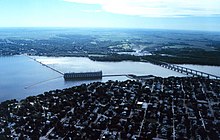Lock and Dam No. 19
| Lock and Dam No. 19 | |
|---|---|

Mississippi River Lock and Dam number 19
|
|
| Location | Hamilton, Illinois / Keokuk, Iowa |
| Coordinates | 40°23′45.46″N 91°22′26.71″W / 40.3959611°N 91.3740861°WCoordinates: 40°23′45.46″N 91°22′26.71″W / 40.3959611°N 91.3740861°W |
| Construction began | 1910 |
| Opening date | 1913 |
| Operator(s) | United States Army Corps of Engineers |
| Dam and spillways | |
| Impounds | Upper Mississippi River |
| Length | 4,620 feet (1,408 m) (movable portion) |
| Reservoir | |
| Creates | Pool 19 / Lake Cooper |
| Total capacity | 292,000 acre·ft (0.360 km3) |
| Catchment area | 119,000 sq mi (310,000 km2) |
|
Lock and Dam No. 19 Historic District
|
|
| Location | 525 N. Water St., Keokuk, Iowa |
| Area | 160.5 acres (65.0 ha) |
| Built | 1870 |
| MPS | Upper Mississippi River 9-Foot Navigation Project MPS |
| NRHP Reference # | 04000179 |
| Added to NRHP | March 10, 2004 |
Lock and Dam No. 19 is a lock and dam located on the Upper Mississippi River near Keokuk, Iowa. In 2004, the facility was listed in the National Register of Historic Places as Lock and Dam No. 19 Historic District, #04000179 covering 1,605 acres (650 ha), 7 buildings, 12 structures, 1 object. The lock is owned and operated by the U.S. Army Corps of Engineers. The dam is owned and operated by Ameren Missouri.
The lock and dam obliterated the Des Moines Rapids which had effectively been the northern barrier for traffic on the Mississippi until efforts began in 1837 to address the Mississippi's 2 ft 6 in (76 cm) depth in the rapids.
The main lock was constructed from 1952 to 1957 and is 1,200 feet (366 m) long and 110 feet (34 m) wide with a lift of just over 38 feet (12 m) and large enough to handle a full-length tow of barges. It was put into operation in 1957 at a cost of 13.5 million dollars. The 1957 lock replaced a 1910-1913 lock. The 1913 lock was a variant of the standardized Panama canal design and was 110 feet (34 m) wide, 358 feet (109 m) long and 57 feet (17 m) tall with a 40 feet (12 m) lift. There was a 130 feet (40 m) wide, 463 feet (141 m) long and 20 feet (6 m) deep dry dock at the site, both the dry dock and 1913 lock were dewatered in 1977 when a sheet pile and cell closure were built blocking the upstream sides of the lock and dry dock.
The lock and dam, as well as the rest of the river, can be viewed from a distance on the Observation Deck of the Keokuk Rail Bridge.
Construction of the dam began in 1910, and was completed in 1913. The movable portion of the dam is 4,620 feet (1,408 m) long with 119 separate 30 feet (9 m) rectangular, steel-skin plated, sliding gates. The gates are either installed or removed and river flow is controlled by the number of gates installed. They are removed by a gantry crane that travels on the service bridge above the dam. At the time it was completed it was second in length only to the Aswan Low Dam on the Nile River.
...
Wikipedia

